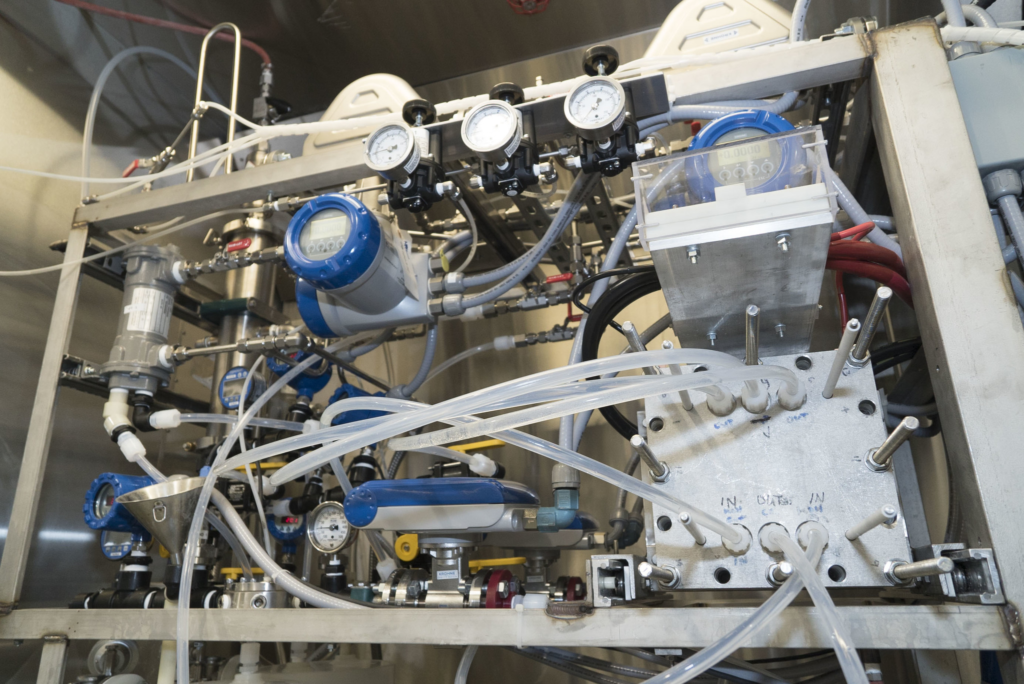What if, in addition to reducing emissions, we could also take carbon out of the atmosphere? That’s what some aspiring researchers around the world have set their sights on – capturing and converting atmospheric carbon dioxide into something useful. One Toronto-based research team, Carbon Electrocatalytic Recycling Toronto (CERT), recently advanced to the final round of the prestigious global NRG COSIA Carbon XPRIZE competition with a promising idea to achieve just that – turning carbon dioxide into a renewable fuel.
CERT is one out of 10 finalists and the first-ever team from Ontario to get this far in the $20 million competition. The team will now have to duke it out with four other competitors in converting emissions from a natural gas-powered electricity demonstration plant in Alberta over the next two years (five other teams will capture emissions from a coal-powered electricity plant in Wyoming).
Employing the latest in nanotechnology and machine learning, CERT uses accelerated materials design for a promising technology that could one day help in the global fight against climate change. CERT, a team of scientists and researchers from the University of Toronto and led by Professor Ted Sargent, received funding from the Ontario Centres of Excellence.

We sat down with Phil De Luna, a PhD candidate in Materials Science Engineering and CERT’s Director of Catalyst Research & Development to learn more about their story.
TAF: What is your process and how does it work?
CERT: Just like how plants take CO2, sunlight, and water and convert that into sugar to feed itself, we design systems to take CO2, renewable energy, and water as an input and produces synthetic fuels. At the heart of this reaction is the catalyst – the material that converts the CO2. We discovered a new material in the lab in 2016 and this was the basis for the technology of CERT. We have been working hard to scale up this lab bench process that uses electricity to convert CO2 emissions.
TAF: What has been the most exciting thing about this competition?
CERT: By far it’s the ability to work with such a great team. Dr. Alex Ip, CERT’s Director of Business Partnerships & Commercialization, has been doing a fantastic job telling people about our work around the world and raising funding. He’s been managing and supervising the project from the beginning and doing a great job. Dr. Cao-Thang Dinh, CERT’s Director of Device Engineering & Scale Up is a genius. He’s been designing these systems and he is extremely talented. Without them, CERT would not exist. There’s also the team of other researchers that we work with day to day, it’s so rewarding being able to collaborate with such smart and capable people.
TAF: How does your process reduce emissions?
CERT: That’s an excellent question! Our process runs on electricity and itself produces no carbon emissions. So the answer is our process is only as clean as the electricity grid with which it is connected to. Relative to fossil fuels, this technology runs on renewable energy, and fortunately, the electricity grid in most provinces is very clean. Ontario is entirely coal-free, and Quebec has massive amounts of renewable hydroelectric power. This means our technology is uniquely positioned to make use of extra-capacity for long-term energy storage.
TAF: Long-term energy storage, can you expand on that a bit? How does your process help to store energy?
CERT: Intermittency of renewables is a problem. This is the main challenge that limits a fully renewable grid. The sun doesn’t shine all the time and the wind doesn’t always blow. At the same time, the peak production times in the day do not necessarily match the peak demand for electricity. What if you could take that excess produced energy, convert it into a stable chemical form such as liquid fuel, and then use it later? That’s the idea of closing the carbon loop and what our technology represents. We are using CO2 as an energy carrier vehicle for renewable energy and this lets us utilize existing infrastructure that was built for fossil fuels.
TAF: That sounds amazing, what’s the catch?
CERT: The catch is we aren’t at scale. We’ve done great work getting to kilograms per day, but emissions are on the megatonnes per day scale, so we have a long way to go.There’s a lot of hard engineering problems that need to be solved to reach the tons per day. Things like cell leakage, catalyst stability, efficiency, product separation and handling, power supplies, there are a million little things we need to troubleshoot and solve as we scale in the final round. But we’re excited and working hard to fix those problems.
TAF: How expensive is this process?
CERT: The answer is, right now, still too expensive. The cost of this process is highly dependent on the cost of electricity, and as this continues to plummet due to solar penetration, our technology becomes more competitive against traditional fossil fuel sources. If we can prove this technology at scale, it will be extremely disruptive to the petrochemical sector. Similar technologies have begun industrial development with start-up companies like Opus-12 targeting CO production. A test plant to produce 20,000 tonnes a year has been announced by Siemens and Evonik on a combined electrocatalytic CO2 to CO and biocatalytic CO to alcohols process. I believe that we are at the cusp of economic viability.
CERT Team Members
Co-Founders and Principle Investigators
- Ted Sargent, University Professor, VP International
- David Sinton, Professor, Canada Research Chair
Directors
- Alex Ip, Business Partnerships & Commercialization
- Phil De Luna, Catalyst Research & Development
- Cao-Thang Dinh, Device Engineering & Scale Up
- Thomas Burdyny, Manufacturing & Cell Design
Researchers
- Oleksandr Bushuyev
- Pelayo Garcia de Arquer
- Jonathan Edwards
- Christine Gabardo
- MD Golam Kibria
